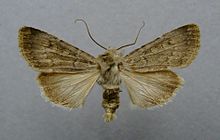You can help expand this article with text translated from the corresponding article in German. (November 2022) Click [show] for important translation instructions.
|
Euxoa decora is a moth of the family Noctuidae. It is found in southern and central Europe, Morocco, Algeria, the Caucasus, Armenia, Issyk-Kul, Turkey, Iran and Iraq.
| Euxoa decora | |
|---|---|

| |
| Scientific classification | |
| Domain: | Eukaryota |
| Kingdom: | Animalia |
| Phylum: | Arthropoda |
| Class: | Insecta |
| Order: | Lepidoptera |
| Superfamily: | Noctuoidea |
| Family: | Noctuidae |
| Genus: | Euxoa |
| Species: | E. decora
|
| Binomial name | |
| Euxoa decora (Denis & Schiffermüller, 1775)
| |
| Synonyms | |
| |

Description
editIt has a typical wingspan of 38–41 mm. Warren states E. decora Schiff. ( nebulosa Hbn., marcens Chr.) (6d). Forewing dull ashgrey, sometimes with a brownish or ochreous tinge; lines dark, often obscure; stigmata pale, sometimes ochreous; claviform, when present , yellowish ; hindwing dull fuscous , with the base paler in male. Common on the Mountains of Central Europe and in Armenia; — in ab. livida Stgr. (6d) the ground colour is dark purplish grey and the stigmata well-defined; the orbicular round and sometimes filled up with ochreous. [1]
Subspecies
edit- Euxoa decora decora (eastern part of the Alps and adjacent regions in the east, northern Italy)
- Euxoa decora simulatrix (western Alps, Pyrenees)
- Euxoa decora splendida (Italy (Abruzzi))
- Euxoa decora macedonica (southern Yugoslasvia, north-western and southern Greece)
- Euxoa decora olympica (central Greece (Olympus and Grammos Mountains))
- Euxoa decora hackeri (northern Greece (Mount Phalakron))
Biology
editEach generation of adults are on wing from July to September, and larvae feed on a wide range of low growing plants, including Anthyllis vulneraria.
References
edit- ^ Warren, W. in Seitz, A. Ed., 1914 Die Großschmetterlinge der Erde, Verlag Alfred Kernen, Stuttgart Band 3: Abt. 1, Die Großschmetterlinge des palaearktischen Faunengebietes, Die palaearktischen eulenartigen Nachtfalter, 1914 This article incorporates text from this source, which is in the public domain.
External links
edit